The Spatial Distribution Characteristics and Driving Factors of Traditional Villages’ Tourism Transformation Level in Shaanxi, China
Abstract
1. Introduction
2. Materials and Methods
2.1. Study Area
2.2. Methods
2.2.1. Geodetector
- (1)
- Factors detector
- (2)
- Interaction detector
2.2.2. Grounded Theory
2.2.3. Indicator System
3. Results
3.1. Spatial Distribution Characteristics of Traditional Villages in Shaanxi
Tourism Village Development
- Quantitative Structural Characteristics
- 2.
- Spatial Differentiation Characteristics
3.2. Analysis of the Influencing Factors Contributing to the Spatial Distribution Characteristics
3.2.1. Meso-Level of Districts and Counties
- Single-Factor Analysis
- 2.
- Interaction Analysis
3.2.2. Micro-Level of Villages
4. Discussion
4.1. Key Factors Influencing the Development of Tourism Development in Traditional Villages
4.2. In-Depth Interview Findings Based on Grounded Theory
- (1)
- Villages with rich cultural and natural assets are prioritized for inclusion in the “Intangible Cultural Heritage Featured Demonstration Counties and Towns” program [37], which promotes the synergy between heritage preservation and tourism development, while providing financial support for immersive cultural spaces and industrial agglomeration. This aligns with the demand for enhanced cultural product innovation expressed in the interview.
- (2)
- Integrate villages into provincial tourism circuits, such as the “Sitting Trains Tour Shaanxi,” [38] and align them with seasonal consumption events to extend visitor stays and balance seasonal demand. Additionally, it leverages the Inbound Tourism Reward Scheme (2025) to encourage the targeting of international markets by offering incentives such as subsidies for overseas media campaigns and visa-free transit tours, thereby expanding the tourist base beyond local visitors.
- (3)
- Establish local incubators for specialized and innovative small- and medium-size enterprises in tourism [39] within the cultural creative industry chain framework [40], supporting resident-led homestays and handicraft businesses. Simultaneously, accelerate the implementation of “5G plus culture and tourism” projects to facilitate virtual tours and smart management, thereby mitigating revenue declines during the off-season [41].
5. Conclusions
Advantages and Limitations
Author Contributions
Funding
Data Availability Statement
Acknowledgments
Conflicts of Interest
Appendix A
| Respondent Background Information |
| 1. Your role: Villager/Village cadre/Tourism practitioner/Other (please specify) |
| 2. Years of residence/work in this village: ______ years |
| 3. Specific role in tourism-related work: ______ |
| Current Status of Village Tourism Development |
| 4. How would you describe the overall current state of tourism development in your village? (Please comment on visitor numbers, tourism revenue, and development trends.) |
| 5. In your opinion, which key events or initiatives have significantly promoted or hindered tourism development in your village? (Please provide specific examples.) |
| Specific Conditions of Village Tourism Development |
| A. Transportation Conditions and Accessibility |
| 6. What are the main modes of transportation used by tourists to reach your village? |
| 7. What changes have occurred in transportation conditions in recent years? |
| 8. What mode of transportation is typically used to travel from your village to the nearest train station/high-speed rail station? Approximately how long does it take? In your opinion, does this accessibility influence tourists’ willingness to visit? |
| 9. Approximately how long does it take to reach the nearest expressway entrance from your village? Is it convenient to access the village from there? |
| 10. Approximately how long does it take to travel from your village to the city center? Do tourists from the city commonly visit your village? |
| 11. Approximately how long does it take to travel from your village to the county center? What is the overall state of tourism development in the county? Do you think it contributes to promoting tourism development in your village? |
| 12. (If transportation is inconvenient) Do you think limited transportation access has restricted the number of tourists? What measures do you think could be taken to improve transportation conditions? |
| 13. Village Resource Endowment and Utilization |
| 14. Which natural landscapes in your village (e.g., rivers, lakes, forests) do you consider most attractive to tourists? Are these resources adequately protected and utilized? |
| 15. Have the elevation differences in terrain (e.g., mountains, terraced fields) been developed into tourism specialty projects? How do villagers make use of these resources? |
| 16. Which other natural resources within the village do you think can be developed and utilized to support village tourism services? |
| 17. Are you aware that your village is designated as a national/provincial-level traditional village? In your opinion, how does the cultural designation of the village affect its tourism popularity? |
| 18. Are there any cultural heritage protection sites in the village? What specific conservation measures are in place, and how do they impact the village’s tourism development? |
| 19. What unique historical and cultural heritage sites or elements (such as buildings, customs, handicrafts) exist in the village? How are they integrated into tourism development? |
| B. County-Level Tourism Resource Base |
| 20. Are there any scenic spots or tourist attractions in or near your village? Do they contribute to the development of tourism in your village? |
| 21. Are there any relatively well-established county-level tourism routes that include your village? Do these routes have a positive impact on the development of tourism in your village? |
| C. Tourism Consumption Basis |
| 22. How would you describe the spending level of tourists (e.g., on dining, accommodation, shopping) based on your observations? Does the local area have the capacity to meet their needs? |
| 23. Has the development of tourism in the village generated corresponding tourism-related income for you? Which tourism projects do you think have contributed to increasing the per capita income of villagers? |
| 24. Has the growth of the county’s total tourism revenue contributed to the improvement of infrastructure in your village? |
| D. Villager Participation |
| 25. In what ways do villagers primarily participate in tourism operations (e.g., catering, homestays, guiding)? What is the level of their participation? |
| 26. Do you think villagers’ tourism service skills (such as reception and marketing) need improvement? If so, which specific skills are lacking? |
| E. Regional Policy Support |
| 27. What types of support has the government provided for tourism in your village (e.g., funding, promotion, training)? What difficulties exist in the implementation of these policies? |
| 28. In your opinion, which aspects of the current policies need improvement (e.g., land-use approval, intangible cultural heritage revitalization policies)? |
| F. Marketing Promotion and Surrounding Environment |
| 29. Through which channels do tourists primarily learn about your village? How does the village promote its unique features (e.g., social media, collaboration with travel agencies)? |
| 30. Do nearby scenic spots or county-level tourism developments act as competition or drivers for your village’s tourism? Please provide examples. |
| Open-ended Questions |
| 31. In addition to the factors discussed above, are there any other significant factors that you believe profoundly affect tourism development in your village? |
| 32. What do you consider to be the greatest obstacles currently limiting the upgrading of tourism in your village (e.g., funding, talent, infrastructure, resource conservation)? |
| 33. What are your expectations and suggestions for the future development of tourism in your village? |
References
- Sun, J. Traditional Villages: Theoretical Connotations and Development Paths. Tour. Trib. 2017, 32, 1–3. [Google Scholar]
- Guiding Opinions on Strengthening the Protection and Development of Traditional Villages. Available online: https://www.mohurd.gov.cn/gongkai/zc/wjk/art/2012/art_17339_212337.html (accessed on 3 July 2025).
- Katapidi, I. Heritage Policy Meets Community Praxis: Widening Conservation Approaches in the Traditional Villages of Central Greece. J. Rural. Stud. 2021, 81, 47–58. [Google Scholar] [CrossRef]
- Ma, H.; Tong, Y. Spatial Differentiation of Traditional Villages Using ArcGIS and GeoDa: A Case Study of Southwest China. Ecol. Inform. 2022, 68, 101416. [Google Scholar] [CrossRef]
- Du, J.; Zhao, B.; Feng, Y. Spatial Distribution and Influencing Factors of Rural Tourism: A Case Study of Henan Province. Heliyon 2024, 10, e29039. [Google Scholar] [CrossRef]
- Xu, Y.; Lu, L. Probing the Long-Term Evolution of Traditional Village Tourism Destinations from a Glocalisation Perspective: A Case Study of Wuzhen in Zhejiang Province, China. Habitat Int. 2024, 148, 103073. [Google Scholar] [CrossRef]
- Jin, L.; Wang, Z.; Chen, X. Spatial Distribution Characteristics and Influencing Factors of Traditional Villages on the Tibetan Plateau in China. Int. J. Environ. Res. Public Health 2022, 19, 13170. [Google Scholar] [CrossRef] [PubMed]
- Feng, X.; Hu, M.; Somenahalli, S.; Bian, X.; Li, M.; Zhou, Z.; Li, F.; Wang, Y. A Study of Spatio-Temporal Differentiation Characteristics and Driving Factors of Shaanxi Province’s Traditional Heritage Villages. Sustainability 2023, 15, 7797. [Google Scholar] [CrossRef]
- Wu, K.; Su, W.; Ye, S.; Li, W.; Cao, Y.; Jia, Z. Analysis on the Geographical Pattern and Driving Force of Traditional Villages Based on GIS and Geodetector: A Case Study of Guizhou, China. Sci. Rep. 2023, 13, 20659. [Google Scholar] [CrossRef]
- Karali, A.; Das, S.; Roy, H. Forty Years of the Rural Tourism Research: Reviewing the Trend, Pattern and Future Agenda. Tour. Recreat. Res. 2024, 49, 173–200. [Google Scholar] [CrossRef]
- Li, Y.; Fan, W.; Yuan, X.; Li, J. Spatial Distribution Characteristics and Influencing Factors of Traditional Villages Based on Geodetector: Jiarong Tibetan in Western Sichuan, China. Sci. Rep. 2024, 14, 11700. [Google Scholar] [CrossRef]
- Su, H.; Wang, Y.; Zhang, Z.; Dong, W. Characteristics and Influencing Factors of Traditional Village Distribution in China. Land 2022, 11, 1631. [Google Scholar] [CrossRef]
- Rodríguez Rangel, M.C.; Sánchez Rivero, M. Spatial Imbalance between Tourist Supply and Demand: The Identification of Spatial Clusters in Extremadura, Spain. Sustainability 2020, 12, 1651. [Google Scholar] [CrossRef]
- Zhu, L.; Li, Y.; Hu, J.; Xu, J.; Qing, Q. Spatial Pattern of Rural Tourism Model Villages in China and Its Influencing Factors. J. Agric. Resour. Environ. 2024, 41, 938–949. [Google Scholar]
- Sarrión-Gavilán, M.D.; Benítez-Márquez, M.D.; Mora-Rangel, E.O. Spatial Distribution of Tourism Supply in Andalusia. Tour. Manag. Perspect. 2015, 15, 29–45. [Google Scholar] [CrossRef]
- González-Ramiro, A.; Gonçalves, G.; Sánchez-Ríos, A.; Jeong, J.S. Using a VGI and GIS-Based Multicriteria Approach for Assessing the Potential of Rural Tourism in Extremadura (Spain). Sustainability 2016, 8, 1144. [Google Scholar] [CrossRef]
- Wang, J.; Xu, C. Geodetector: Principles and Prospects. Acta Geogr. Sin. 2017, 72, 116–134. [Google Scholar]
- Zou, Q.; Sun, J.; Luo, J.; Cui, J.; Kong, X. Spatial Patterns of Key Villages and Towns of Rural Tourism in China and Their Influencing Factors. Sustainability 2023, 15, 13330. [Google Scholar] [CrossRef]
- Glaser, B.G.; Strauss, A.L.; Strutzel, E. The Discovery of Grounded Theory; Strategies for Qualitative Research. Nurs. Res. 1968, 17, 364. [Google Scholar] [CrossRef]
- Rahimi-Feyzabad, F.; Yazdanpanah, M.; Gholamrezai, S.; Ahmadvand, M. Institutional Constraints to Groundwater Resource Management in Arid and Semi-Arid Regions: A Straussian Grounded Theory Study. Hydrogeol. J. 2021, 29, 925–947. [Google Scholar] [CrossRef]
- Wang, H.; Wang, H. Research on the Tourism-Promoting Rural Revitalisation Model Based on Grounded Theory: The Case of Shibadong Village in Huayuan County, Hunan Province. Sustainability 2024, 16, 10942. [Google Scholar] [CrossRef]
- Miani, A.M.; Dehkordi, M.K.; Siamian, N.; Lassois, L.; Tan, R.; Azadi, H. Toward Sustainable Rural Livelihoods Approach: Application of Grounded Theory in Ghazni Province, Afghanistan. Appl. Geogr. 2023, 154, 102915. [Google Scholar] [CrossRef]
- Fafurida, F.; Purwaningsih, Y.; Mulyanto, M.; Suryanto, S. Tourism Village Development: Measuring the Effectiveness of the Success of Village Development. Economies 2023, 11, 133. [Google Scholar] [CrossRef]
- Deller, S. Rural Poverty, Tourism and Spatial Heterogeneity. Ann. Tour. Res. 2010, 37, 180–205. [Google Scholar] [CrossRef]
- Zhu, L.; Meng, J.; Zhu, L. Applying Geodetector to Disentangle the Contributions of Natural and Anthropogenic Factors to NDVI Variations in the Middle Reaches of the Heihe River Basin. Ecol. Indic. 2020, 117, 106545. [Google Scholar] [CrossRef]
- Wang, H.; Qin, F.; Xu, C.; Li, B.; Guo, L.; Wang, Z. Evaluating the Suitability of Urban Development Land with a Geodetector. Ecol. Indic. 2021, 123, 107339. [Google Scholar] [CrossRef]
- Milliken, P.J.; Schreiber, R. Examining the Nexus between Grounded Theory and Symbolic Interactionism. Int. J. Qual. Methods 2012, 11, 684–696. [Google Scholar] [CrossRef]
- Qi, J.; Lu, Y.; Han, F.; Ma, X.; Yang, Z. Spatial Distribution Characteristics of the Rural Tourism Villages in the Qinghai-Tibetan Plateau and Its Influencing Factors. Int. J. Environ. Res. Public Health 2022, 19, 9330. [Google Scholar] [CrossRef] [PubMed]
- Zhu, Y.; Zhou, X.; Chen, S.; Tu, Z. Spatial Distribution and Influencing Factors of Key Rural Tourism Villages in China. J. Cent. China Norm. Univ. 2020, 54, 874–912. [Google Scholar] [CrossRef]
- Tao, G.; Li, X.; Tian, S.; Li, H.; Song, Y. Influence of Human Settlements Factors on the Spatial Distribution Patterns of Traditional Villages in Liaoning Province. Humanit. Soc. Sci. Commun. 2024, 11, 1757. [Google Scholar] [CrossRef]
- Hu, Q.; Yang, P.; Ma, J.; Wang, M.; He, X. The Spatial Differentiation Characteristics and Influencing Mechanisms of Intangible Cultural Heritage in China. Heliyon 2024, 10, e38689. [Google Scholar] [CrossRef]
- Gao, L.; Ariffin, N.F.M.; Hussein, M.K.; Liu, S.; Wang, B. An Integrated Approach towards Conservation of Traditional Patterns in Chinese Traditional Villages: A Systematic Literature Review. Environ. Behav. Proc. J. 2024, 9, 157–163. [Google Scholar] [CrossRef]
- Xie, Y.; Meng, X.; Cenci, J.; Zhang, J. Spatial Pattern and Formation Mechanism of Rural Tourism Resources in China: Evidence from 1470 National Leisure Villages. ISPRS Int. J. Geo-Inf. 2022, 11, 455. [Google Scholar] [CrossRef]
- Tian, C.; Guan, X.; Tian, H. Spatial distribution characteristic and its influencing factors of key rural tourism villages in the Yellow River basin. Tour. Trib. 2023, 38, 32–44. [Google Scholar] [CrossRef]
- Li, B.; Wang, J.; Jin, Y. Spatial Distribution Characteristics of Traditional Villages and Influence Factors Thereof in Hilly and Gully Areas of Northern Shaanxi. Sustainability 2022, 14, 15327. [Google Scholar] [CrossRef]
- Dai, M.L.; Fan, D.X.F.; Wang, R.; Ou, Y.H.; Ma, X.L. Does Rural Tourism Revitalize the Countryside? An Exploration of the Spatial Reconstruction through the Lens of Cultural Connotations of Rurality. J. Destin. Mark. Manag. 2023, 29, 100801. [Google Scholar] [CrossRef]
- Notice by the Shaanxi Provincial Department of Culture and Tourism on Organizing the Application and Establishment of Intangible Cultural Heritage Demonstration Counties (Cities, Districts), Demonstration Towns, and Demonstration Blocks for the Period 2023–2025. Available online: https://www.ihchina.cn/news_2_details/28057.html (accessed on 26 July 2025).
- Implementation Plan for Promoting Inbound Tourism in Shaanxi Province (2025). Available online: https://whhlyt.shaanxi.gov.cn/zfxxgk/fdzdgknr/lzyj/tzgg/202504/t20250414_3492008.html (accessed on 26 July 2025).
- Hajilo, M.; Ghadiri Masoom, M.; Motiee Langroudi, S.H.; Faraji Sabokbar, H.; Pennington-Gray, L. Spatial Analysis of the Distribution of Small Businesses in the Eastern Villages of Gilan Province with Emphasis on the Tourism Sector in Mountainous Regions. Sustainability 2017, 9, 2238. [Google Scholar] [CrossRef]
- Implementation Opinions of Shaanxi Province on Developing a Trillion-Yuan Cultural Tourism Industry (2021–2025). Available online: https://whhlyt.shaanxi.gov.cn/zfxxgk/fdzdgknr/lzyj/xzgfxwj/202209/t20220907_2578930.html (accessed on 26 July 2025).
- The 2025 Shaanxi Summer Cultural and Tourism Consumption Season and the 9th Shaanxi Tourism Consumption Season Kick-off Ceremony. Available online: https://whhlyt.shaanxi.gov.cn/sy/wlyw/202507/t20250707_3539971.html (accessed on 26 July 2025).
- Sun, T.; Li, Y.; Tai, H. Different Cultures, Different Images: A Comparison between Historic Conservation Area Destination Image Choices of Chinese and Western Tourists. J. Tour. Cult. Change 2023, 21, 110–127. [Google Scholar] [CrossRef]
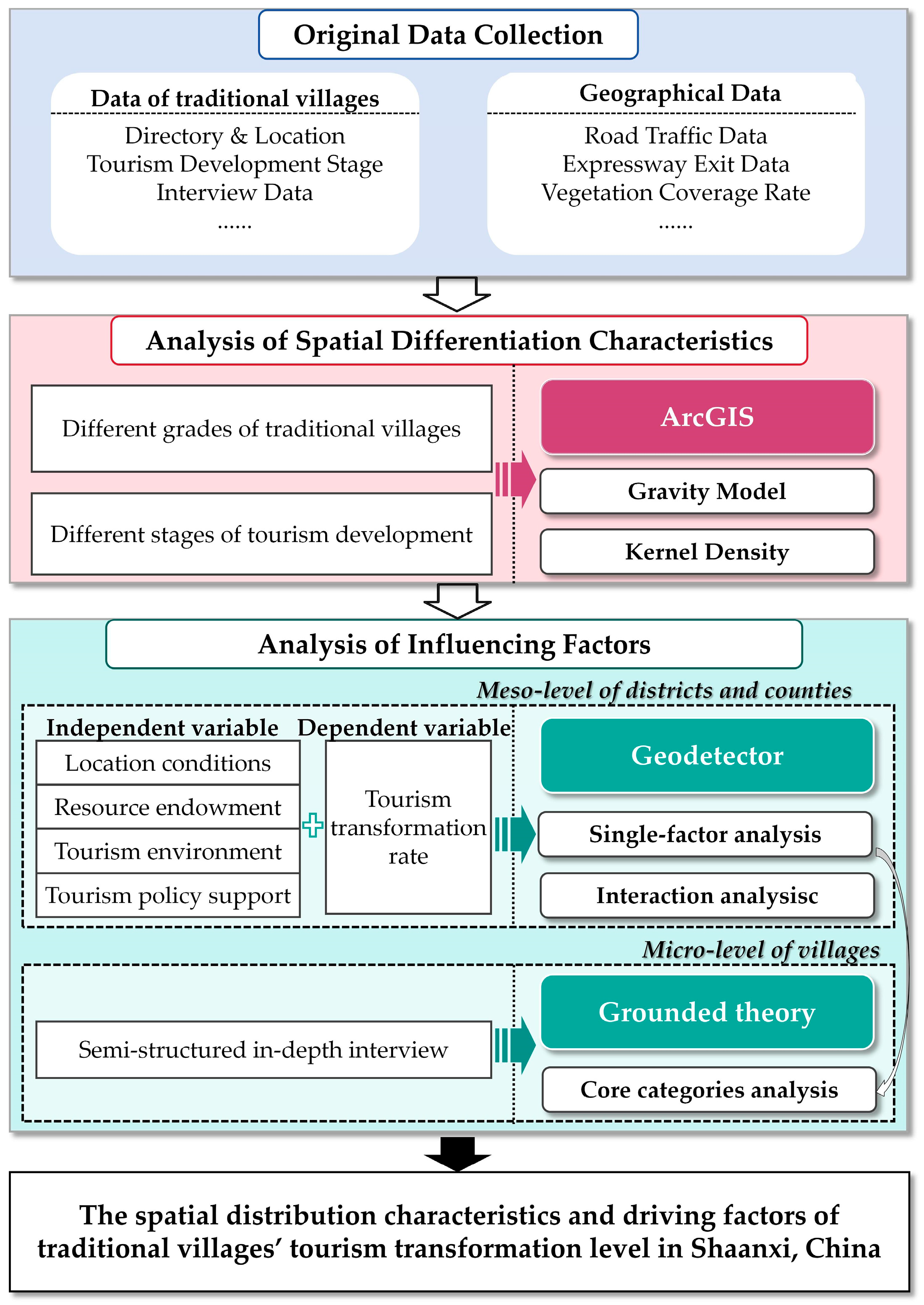
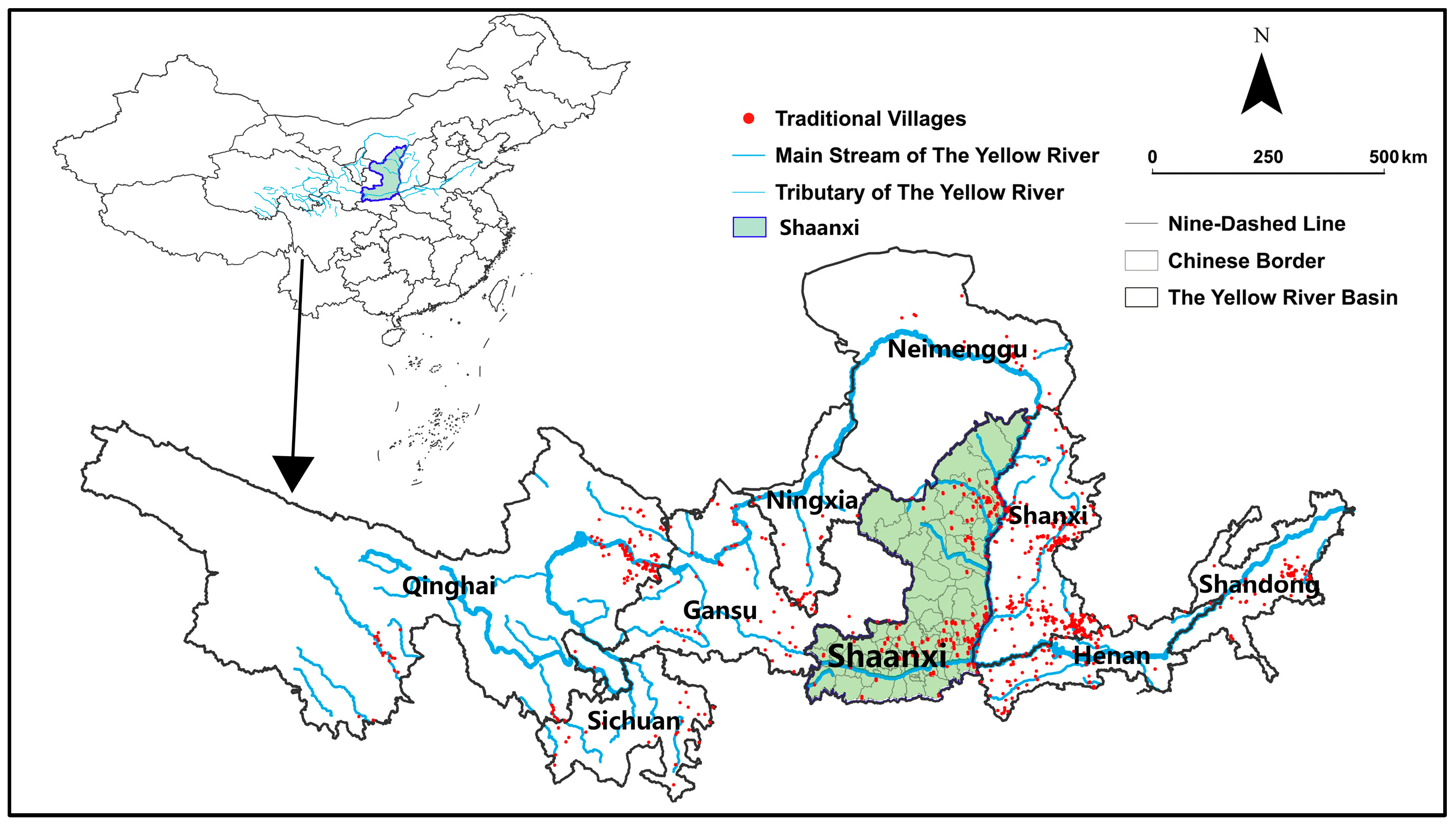
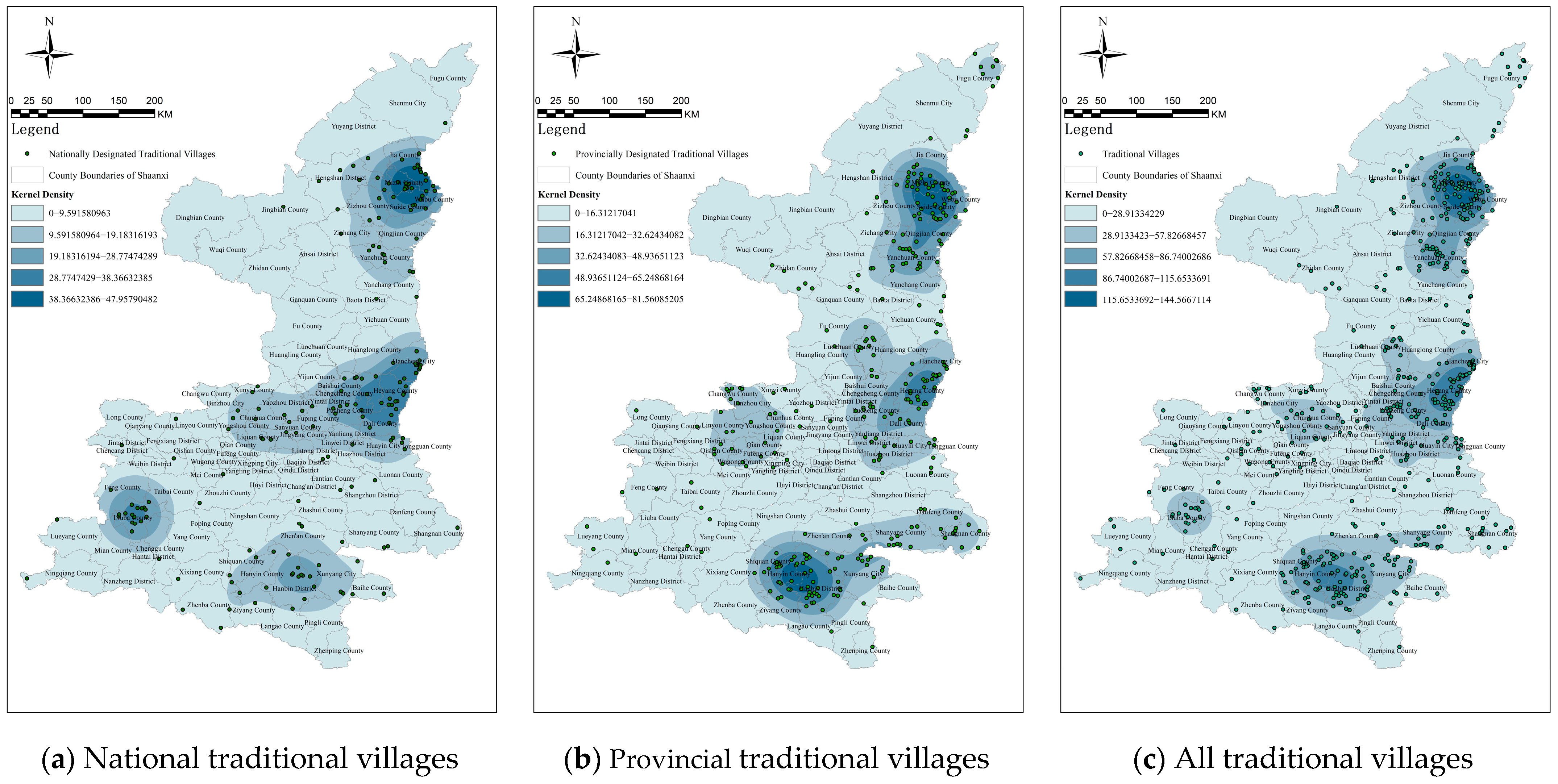

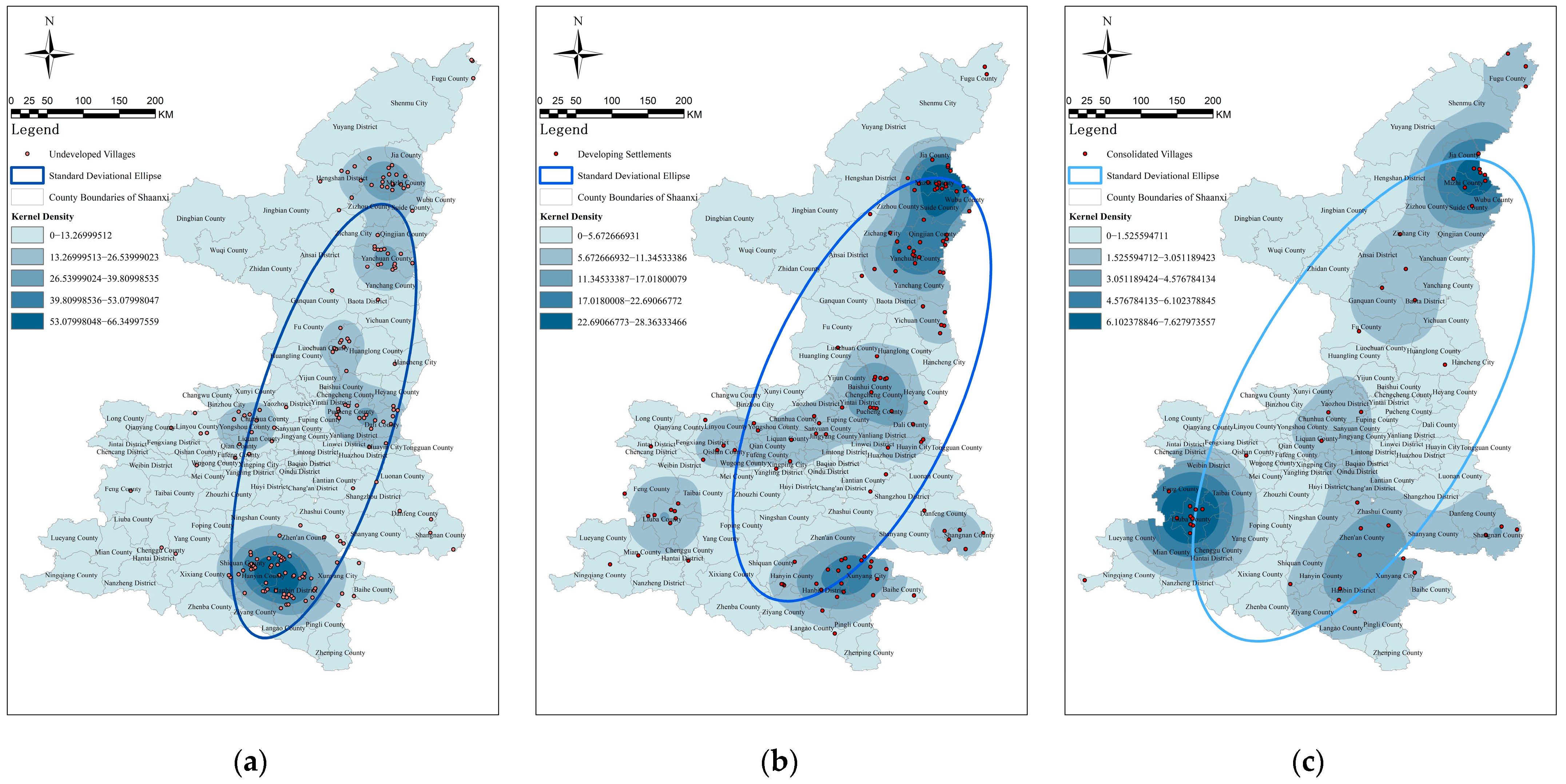
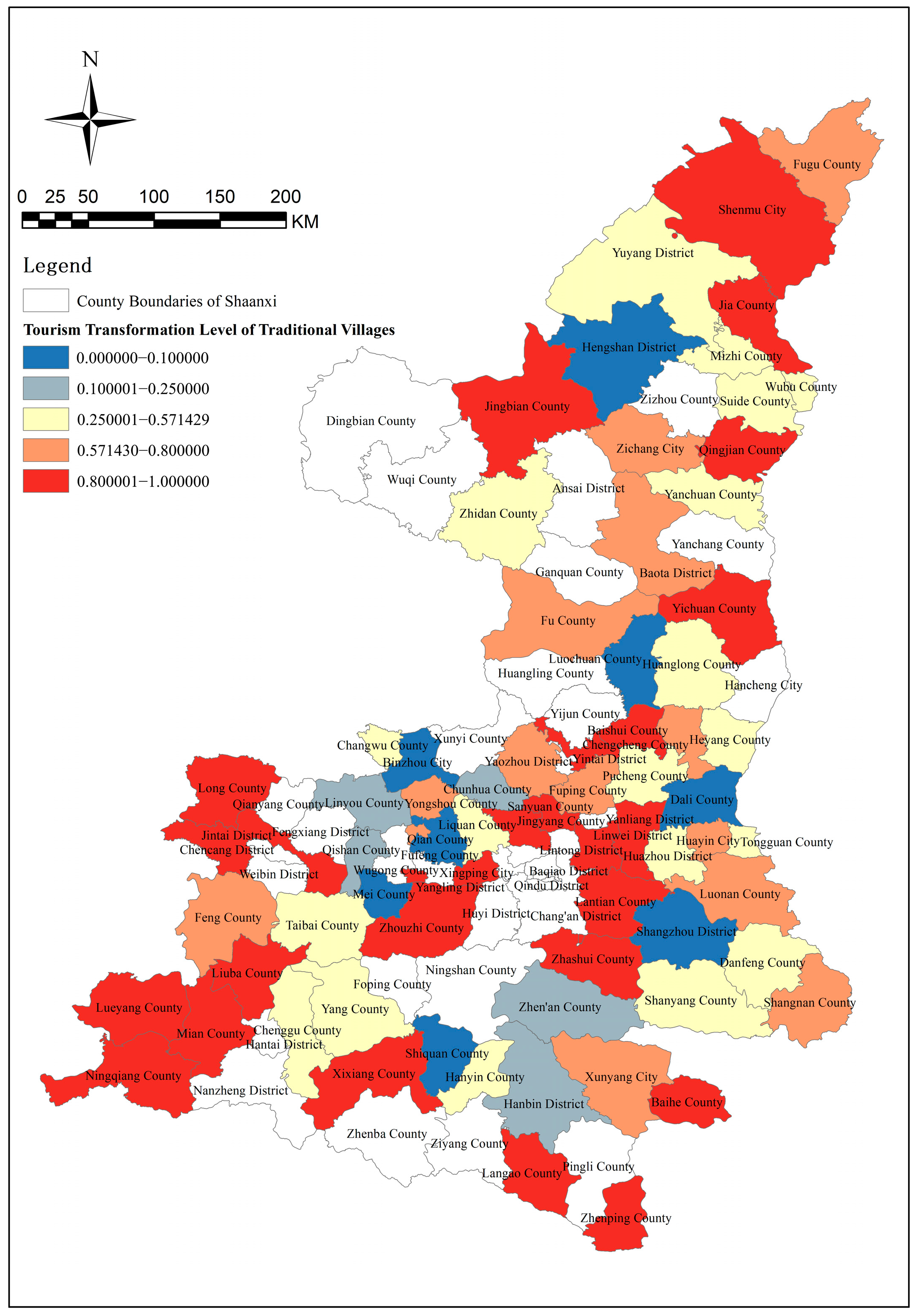
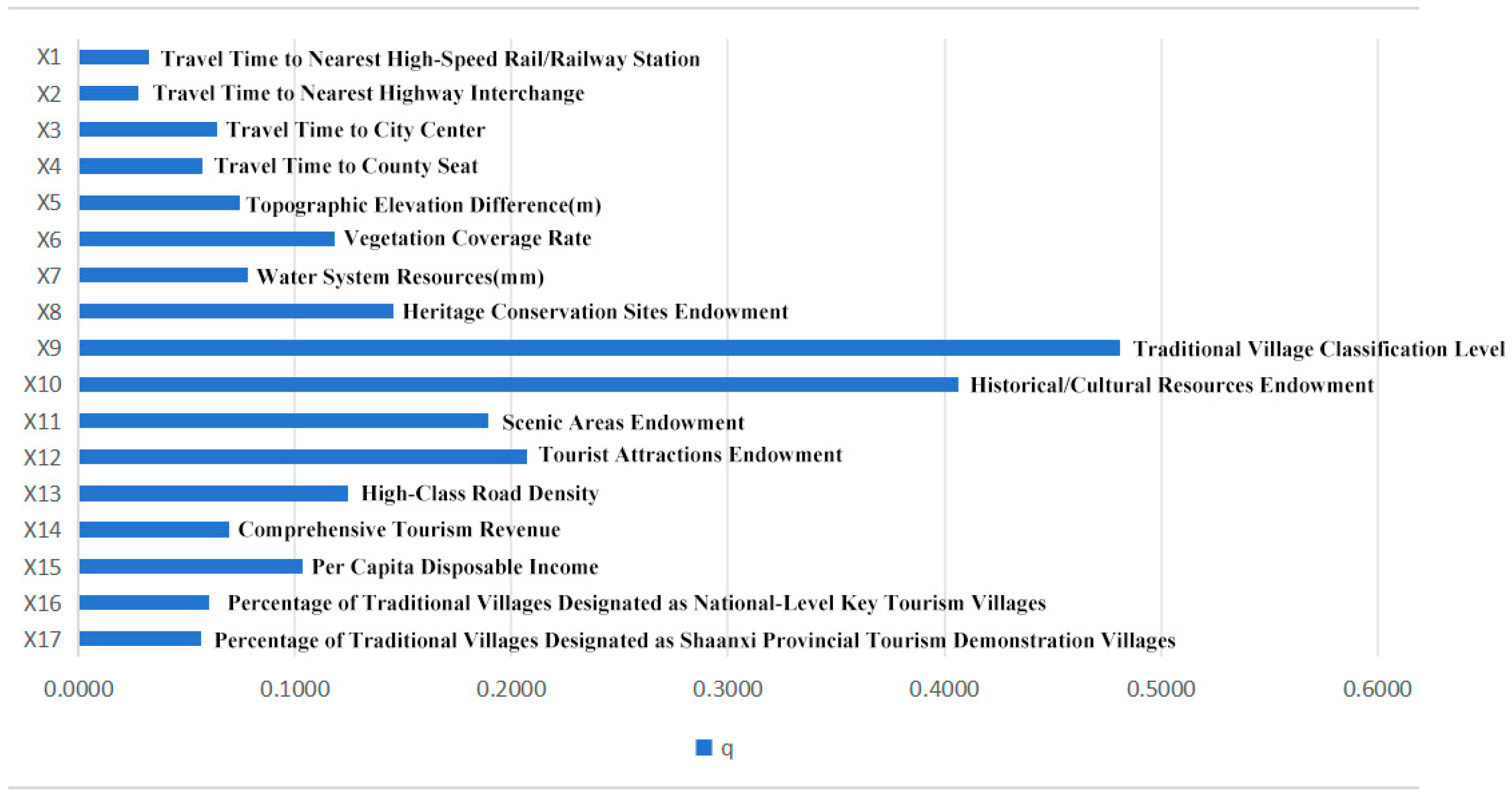
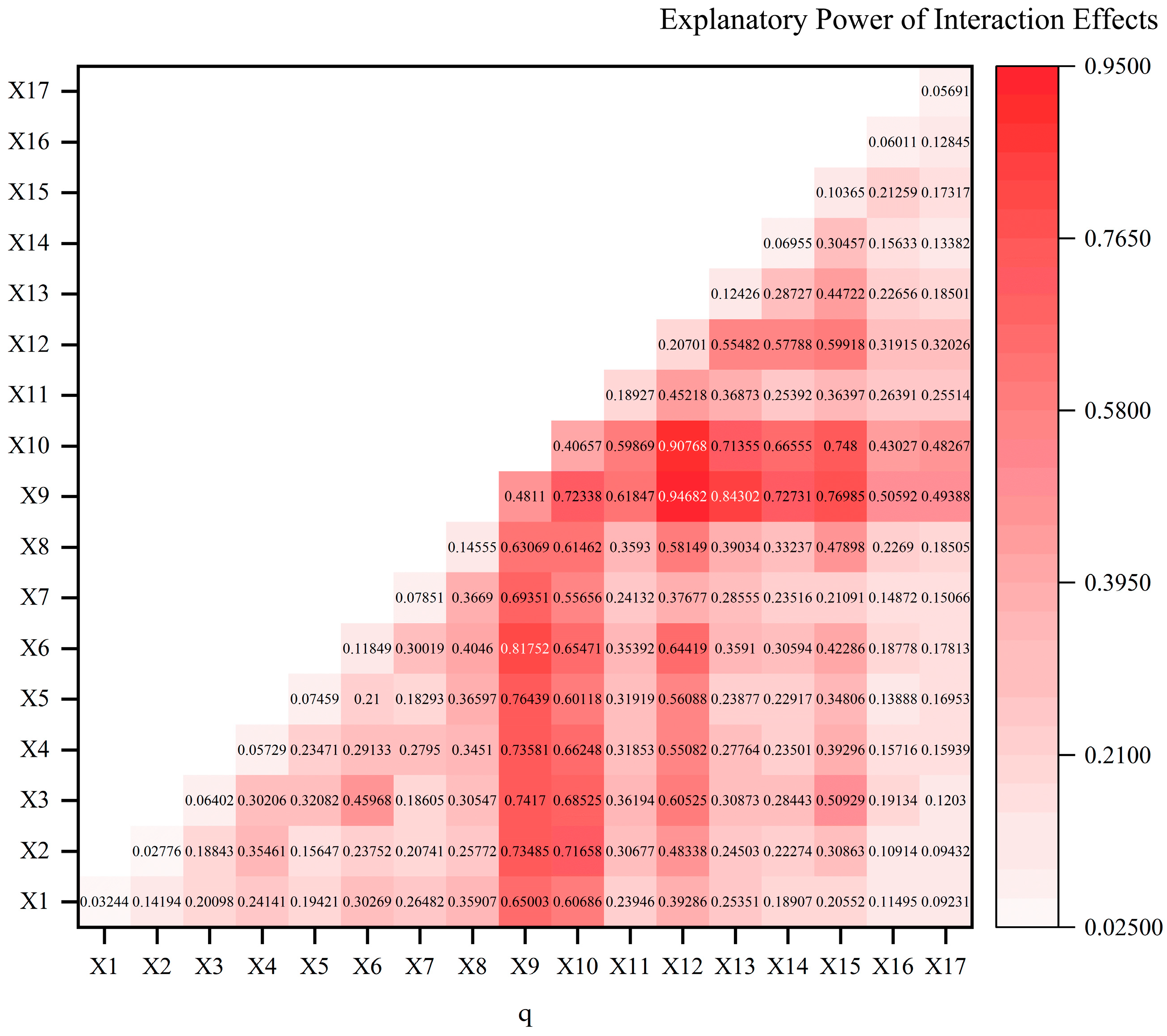
| Respects | Sub-Respects | Variables | Graded Assignment | Data Sources |
|---|---|---|---|---|
| Location conditions | * Transportation location | X1: Travel Time from traditional village to the Nearest High-Speed Railway Station | Within 10 min = 5 points; 10 < X ≤ 30 min = 4 points; 30 < X ≤ 60 min = 3 points; 60 < X ≤ 120 min = 2 points; Over 120 min = 1 point | National Catalogue Service for Geographic Information; the Department of Transport of Shaanxi Province. |
| X2: Travel Time from traditional village to the Nearest Highway entrance | ||||
| Consumer location | X3: Travel Time from traditional village to City center | |||
| X4: Travel Time from traditional village to County center | ||||
| Resource endowment | Natural resources | X5: Elevation difference | Difference between the highest and lowest elevation | Star Map Cloud Open Platform (https://open.geovisearth.com/service/resource (accessed on 12 January 2025)). |
| X6: Vegetation coverage rate | Average NDVI value within the village | |||
| X7: Water resources | Total length of river within the village | |||
| Cultural resources | X8: Heritage values | Values = Number of the national cultural relics protection units × 5 + number of provincial cultural relics protection units × 2 | Department of Transport of Shaanxi Province and Shaanxi Provincial Department of culture and Tourism | |
| X9: Traditional Village type | 5 points for national traditional village, 3 points for provincial traditional villages | |||
| Tourism environment | Tourism resource | X10: Cultural Resources values within the whole county | Values = Number of the national historical and cultural towns × 8 + Number of the provincial historical and cultural towns × 6 + Number of the national historical and cultural villages × 6 + umber of the provincial historical and cultural villages × 4 + Number of the national traditional villages × 5 + Number of the provincial traditional villages × 3 | Shaanxi Provincial Department of culture and Tourism |
| X11: Scenic values within the whole county | 8 points for national-level, 6 points for provincial-level | |||
| X12: Tourist attraction values within the whole county | Values = Number of 5A scenic spots c × 6 + Number of 4A scenic spots × 4 + Number of 3A scenic spots × 2. | |||
| * Tourism transportation | X13: Density of national and provincial highways within the whole county | —— | National Catalogue Service For Geographic Information | |
| Tourism consumption | X14: Tourism Revenue of the whole county | —— | Online searches, government emails, and telephone inquiries; | |
| X15: Per capita disposable income | —— | |||
| Tourism policy support | X16: Proportion of traditional villages designated as national rural tourism destination | —— | Department of Transport of Shaanxi Province and Shaanxi Provincial Department of culture and Tourism | |
| X17: Proportion of traditional villages designated as provincial rural tourism demonstration | —— |
| Typology | District/County (Total Number of Traditional Villages/Number of National-Level Villages) | Mature Tourism Stage | Developing Tourism Stage | Pre-Tourism Stage | |||
|---|---|---|---|---|---|---|---|
| Total Number | National-Level | Total Number | National-Level | Total Number | National-Level | ||
| High tourism development achievements | Zhouzhi County (2/2) | 0 | 0 | 2 | 2 | 0 | 0 |
| Liuba County (16/16) | 9 | 9 | 7 | 7 | 0 | 0 | |
| Lueyang County (3/1) | 0 | 0 | 3 | 1 | 0 | 0 | |
| Ningqiang County (1/1) | 1 | 1 | 0 | 0 | 0 | 0 | |
| Jiaxian County (13/13) | 6 | 6 | 7 | 7 | 0 | 0 | |
| Low tourism development achievements | Hengshan District (6/4) | 0 | 0 | 0 | 0 | 6 | 4 |
| Shiquan County (13/2) | 1 | 1 | 0 | 0 | 12 | 1 | |
| Dali County (12/6) | 0 | 0 | 1 | 0 | 11 | 6 | |
| Mei County (1/0) | 0 | 0 | 0 | 0 | 1 | 0 | |
| Qian County (3/0) | 0 | 0 | 0 | 0 | 3 | 0 | |
| Factor Interaction | Interaction Value Comparison | Interaction Results |
|---|---|---|
| X10 ∩ X1 | 0.6069 > q (X10 + X1 = 0.4390) | Nonlinear enhancement |
| X10 ∩ X2 | 0.7166 > q(X10 + X2 = 0.4343) | Nonlinear enhancement |
| X10 ∩ X3 | 0.6852 > q (X10 + X3 = 0.4706) | Nonlinear enhancement |
| X10 ∩ X4 | 0.6625 > q (X10 + X4 = 0.4639) | Nonlinear enhancement |
| X10 ∩ X5 | 0.6012 > q (X10 + X5 = 0.4812) | Nonlinear enhancement |
| X10 ∩ X6 | 0.6457 > q (X10 + X6 = 0.5251) | Nonlinear enhancement |
| X10 ∩ X7 | 0.5566 > q (X10 + X7 = 0.04851) | Nonlinear enhancement |
| X10 ∩ X8 | 0.6146 > q (X10 + X8 = 0.5521) | Nonlinear enhancement |
| X10 ∩ X9 | 0.7234 > max (q (X10 = 0.4066), q (X9 = 0.4811) | Bivariate enhancement |
| X10 ∩ X11 | 0.5987 > max (q (X10 = 0.4066), q (X11 = 0.1893)) | Bivariate enhancement |
| X10 ∩ X12 | 0.9077 > q (X10 + X12 = 0.6136) | Nonlinear enhancement |
| X10 ∩ X13 | 0.7135 > q (X10 + X13 = 0.5308) | Nonlinear enhancement |
| X10 ∩ X14 | 0.6656 > q (X10 + X14 = 0.4761) | Nonlinear enhancement |
| X10 ∩ X15 | 0.7480 > q (X10 + X15 = 0.5102) | Nonlinear enhancement |
| X10 ∩ X16 | 0.4303 > max (q (X10 = 0.4066), q (X16 = 0.0040)) | Bivariate enhancement |
| X10 ∩ X17 | 0.4775 > q (X10 + X17 = 0.4331) | Nonlinear enhancement |
| Selective Coding | Categories Extracted Through Axial Coding | Frequency | Initial Category | Original Statement | |
|---|---|---|---|---|---|
| Core Categories | Subcategories | ||||
| Resource | Village resource endowment | Natural environment | 46 | Village climate conditions; Natural landscape of the village | It is quite cool in our village in summer. The water in this river is very refreshing, and there are many trees along the way. It is a great place to escape the summer. |
| Landscape planting | 24 | Ancient tree resources; Characteristic landscape | There is a Reevesia pubescens, which is said to be a thousand-year-old tree. This place has been named after this tree since ancient times. | ||
| Intangible culture | 52 | Intangible cultural heritage Special activities; Cultural resources | Nowadays, the intangible cultural heritages in the village, such as bamboo weaving and other handicraft intangible cultural heritages, are quite attractive. | ||
| Material culture | 19 | Village historical buildings | In our village, there is an ancient plank road called Wenchuan Road. There are also many ruins of ancient plank roads over the Baohe River. | ||
| County-level tourism resources | The endowment of county-level tourism resources | 12 | County-level tourist attractions County-level historical and cultural resources | The tourism resources of the entire county are still quite abundant. The Zibai Mountain and ski resort in Liuba County have received a lot of publicity and are frequented by many people. | |
| Group | Residents’ behavior | —— | 29 | Villagers’ subjectivity Villagers’ participation in tourism | About 30% to 40% of the villagers in our village are directly or indirectly involved in the development of local homestays, tourism, and other industries. |
| The role of government | Government action empowerment | 114 | Improvement and renovation of village appearance; Government policy support; Government funding input; the government organizes training. Promotion of government projects Government publicity and promotion | There is also project support. Leaders from the town and county often go out to attract investment. For instance, the “Bird Gathering” homestay is a project that was brought in. | |
| Tourism planning and coordinated development | 32 | Coordinated development of village tourism County-level tourism master plan | The overall planning of the county has connected all the tourism routes and also included the urban area, which can promote development. | ||
| Transportation | Regional traffic | Distance between cities and counties | 53 | Distance to the city center; Distance to the county center | Most tourists who come to play for a day choose to stay around Liuba County for the night. Our village is close to the county town and has a geographical advantage. |
| External traffic | 48 | Mode of transportation; Traffic accessibility | The transportation is quite convenient. Most people come by car themselves. | ||
Disclaimer/Publisher’s Note: The statements, opinions and data contained in all publications are solely those of the individual author(s) and contributor(s) and not of MDPI and/or the editor(s). MDPI and/or the editor(s) disclaim responsibility for any injury to people or property resulting from any ideas, methods, instructions or products referred to in the content. |
© 2025 by the authors. Licensee MDPI, Basel, Switzerland. This article is an open access article distributed under the terms and conditions of the Creative Commons Attribution (CC BY) license (https://creativecommons.org/licenses/by/4.0/).
Share and Cite
Jia, H.; Li, L.; Wu, S.; Zhao, R.; Yang, H. The Spatial Distribution Characteristics and Driving Factors of Traditional Villages’ Tourism Transformation Level in Shaanxi, China. Land 2025, 14, 1602. https://doi.org/10.3390/land14081602
Jia H, Li L, Wu S, Zhao R, Yang H. The Spatial Distribution Characteristics and Driving Factors of Traditional Villages’ Tourism Transformation Level in Shaanxi, China. Land. 2025; 14(8):1602. https://doi.org/10.3390/land14081602
Chicago/Turabian StyleJia, Huidi, Lanbo Li, Siying Wu, Ruiqi Zhao, and Huan Yang. 2025. "The Spatial Distribution Characteristics and Driving Factors of Traditional Villages’ Tourism Transformation Level in Shaanxi, China" Land 14, no. 8: 1602. https://doi.org/10.3390/land14081602
APA StyleJia, H., Li, L., Wu, S., Zhao, R., & Yang, H. (2025). The Spatial Distribution Characteristics and Driving Factors of Traditional Villages’ Tourism Transformation Level in Shaanxi, China. Land, 14(8), 1602. https://doi.org/10.3390/land14081602






